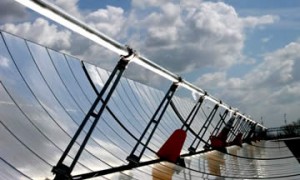 In the face of the utterly depressing final confirmation that the proposed energy bill has been abandoned in the US Senate in the face of Republican opposition, and the realisation that Obama has let the opportunity die without a fight, as Joe Romm puts it, I cast around for something cheering this morning. I found it in an interesting article on Chris Goodall’swebsite Carbon Commentary. The article describes the world’s first molten salts Concentrating Solar Power (CSP) plant. It’s not the first to use molten salts, in that many of the newer CSP plants use molten salts storage to extend the plant’s daily operating hours, but it is the first to use molten salts not just to store heat but also to collect it from the sun in the first place. Normally, pressurised oil which heats up to around 390 degrees is used to collect the heat.
In the face of the utterly depressing final confirmation that the proposed energy bill has been abandoned in the US Senate in the face of Republican opposition, and the realisation that Obama has let the opportunity die without a fight, as Joe Romm puts it, I cast around for something cheering this morning. I found it in an interesting article on Chris Goodall’swebsite Carbon Commentary. The article describes the world’s first molten salts Concentrating Solar Power (CSP) plant. It’s not the first to use molten salts, in that many of the newer CSP plants use molten salts storage to extend the plant’s daily operating hours, but it is the first to use molten salts not just to store heat but also to collect it from the sun in the first place. Normally, pressurised oil which heats up to around 390 degrees is used to collect the heat.
Molten salts can operate at higher temperatures than oils, up to 550 degrees, thus increasing the efficiency and power output of a plant. With the higher-temperature heat storage allowed by the direct use of salts, the plant can also extend its operating hours longer than an oil-operated CSP plant with molten salt storage, working, the article claims, 24 hours a day for several days even in the absence of sun or during rainy days.
This feature also enables a simplified plant design, as it avoids the need for oil-to-salts heat exchangers, and eliminates the safety and environmental concerns related to the use of oils.
Significantly, the higher temperatures reached by the molten salts enable the use of steam turbines at the standard pressure/temperature parameters as used in most common gas-cycle fossil power plants. This means that conventional power plants can be integrated – or, in perspective, replaced – with this technology without expensive retrofits to the existing assets. The first plant, a small one of 5 MW, located in Priolo Gargallo (Sicily), is fully integrated to an existing combined-cycle gas power plant.
A small comfort, perhaps. However the writer describes it as a top-notch world’s first, expensive at around 60 million euros but with overwhelming scope for a massive roll-out of the new technology at utility scale in sunny regions like Northern Africa, the Middle East, Australia, the US.
Solar power is certain to play a large part globally in a future of renewable energy, if we don’t destroy that future before it arrives, and the constant improvements in harnessing the power of the sun are highly encouraging.
Meanwhile back in New Zealand the government has today released a draft of its proposed new energy strategy, which Gerry Brownlee announced the need for shortly after becoming Minister of Energy because the previous one was just “an idealistic vision document for carbon neutrality”. I’ve only had a cursory look so far, but it certainly looks like the great step backwards that he signalled. In the section headed Areas of Focus the leading item is “Develop petroleum and mineral fuel resources.” This is what it means:
“The country already benefits substantially from the revenue gathered from the development and sale of petroleum and coal resources, and both are significant export earners.
“Further commercialisation of petroleum and mineral fuel resources has the potential to produce a step change in economic growth for the country.”
The document does move on to renewables:
“The Government retains the aspirational, but achievable, target that 90 percent of electricity generation be from renewable sources by 2025 (in an average hydrological year) providing this does not affect security of supply.”
But we’re not going to get carried away with aspiration:
“Achieving this target must not be at the expense of the security and reliability of our electricity supply. For the foreseeable future some fossil fuel generation will be required to support supply security.”
There is some useful stuff on renewables and on new technologies, but the minister is obviously unwilling to face the reality of what continuing to produce and burn petroleum and coal actually means for the climate. It means hell and high water, to use Joe Romm’s words in his book of that title. In that book Romm also said that the global warming problem is a now only a problem of politics and political will. Technologies advance, but politicians lag.

 Apparently there’s too much preaching going on from climate scientists. That’s the message from the UK’s new climate change minister, Greg Barker. Of all the things the minister might have found to say this is surely one of the silliest. Reuter’s
Apparently there’s too much preaching going on from climate scientists. That’s the message from the UK’s new climate change minister, Greg Barker. Of all the things the minister might have found to say this is surely one of the silliest. Reuter’s 
 I opened the farming page of the Waikato Times yesterday evening to see a prediction from Lincoln University agribusiness professor
I opened the farming page of the Waikato Times yesterday evening to see a prediction from Lincoln University agribusiness professor